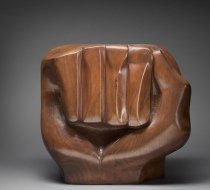Black Unity- a powerful symbol of the Black Power movement Favorite
Sculptor and printmaker Elizabeth Catlett (1915-2012) used her art to advocate for social change in both the U.S. and her adopted country of Mexico. Much of her work focuses on the experience of African American life and political struggle during the middle of the 20th century. Her posters of well-known activists, including Angela Davis and Malcolm X, were widely circulated at the time.
Catlett’s 1968 wooden sculpture, Black Unity, shows the raised fist that became a powerful symbol of the Black Power movement. The work is featured in the monumental exhibition Soul of a Nation: Art in the Age of Black Power, which is traveling around the United States after the Tate Modern organized it in 2017.
In 1946, Catlett was awarded a fellowship that sent her to Mexico City, where she worked for twenty years and eventually became head of the sculpture department for the Escuela Nacional de Artes Plásticas. During this time, she met Diego Rivera and Frida Kahlo, who inspired her artistic and political work. In 1949 she was arrested during a railroad workers protest in Mexico City. The U.S. State Department barred her from entering the U.S. and declared her an “undesirable alien” because of her political affiliations. She was unable to return home to visit her ill mother before she died. In 1962, she renounced her American citizenship and became a Mexican citizen, although she eventually regained her American citizenship in 2002.
According to the artist, the main purpose of her work is to convey social messages rather than pure aesthetics. Art students study her work looking for dramatic ways to use social activist art to effect change in race, gender, and class issues.






